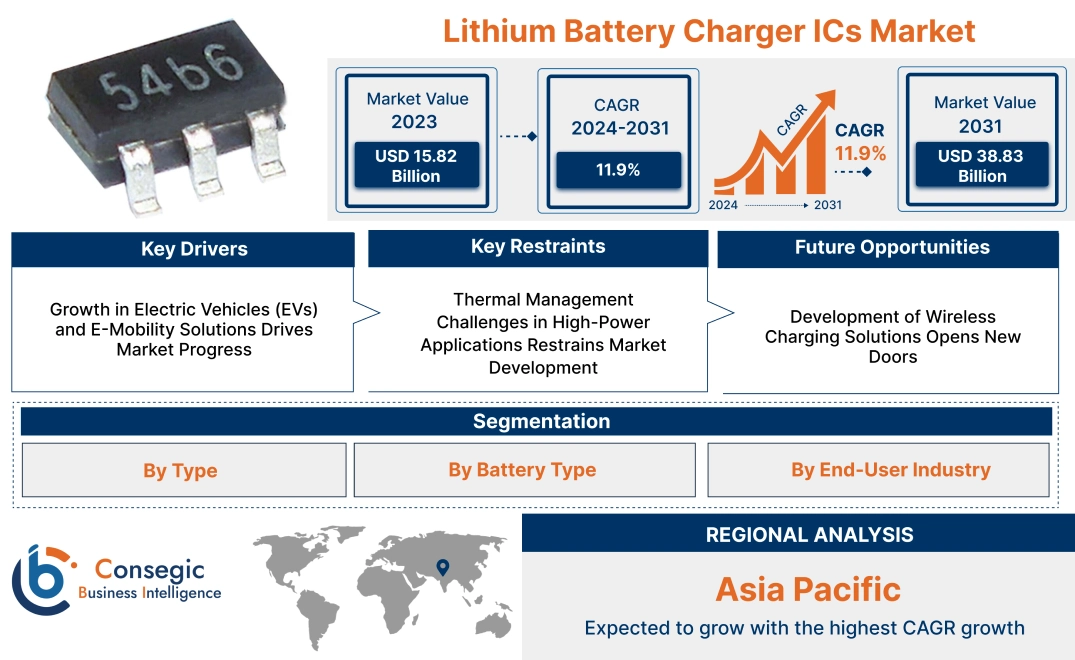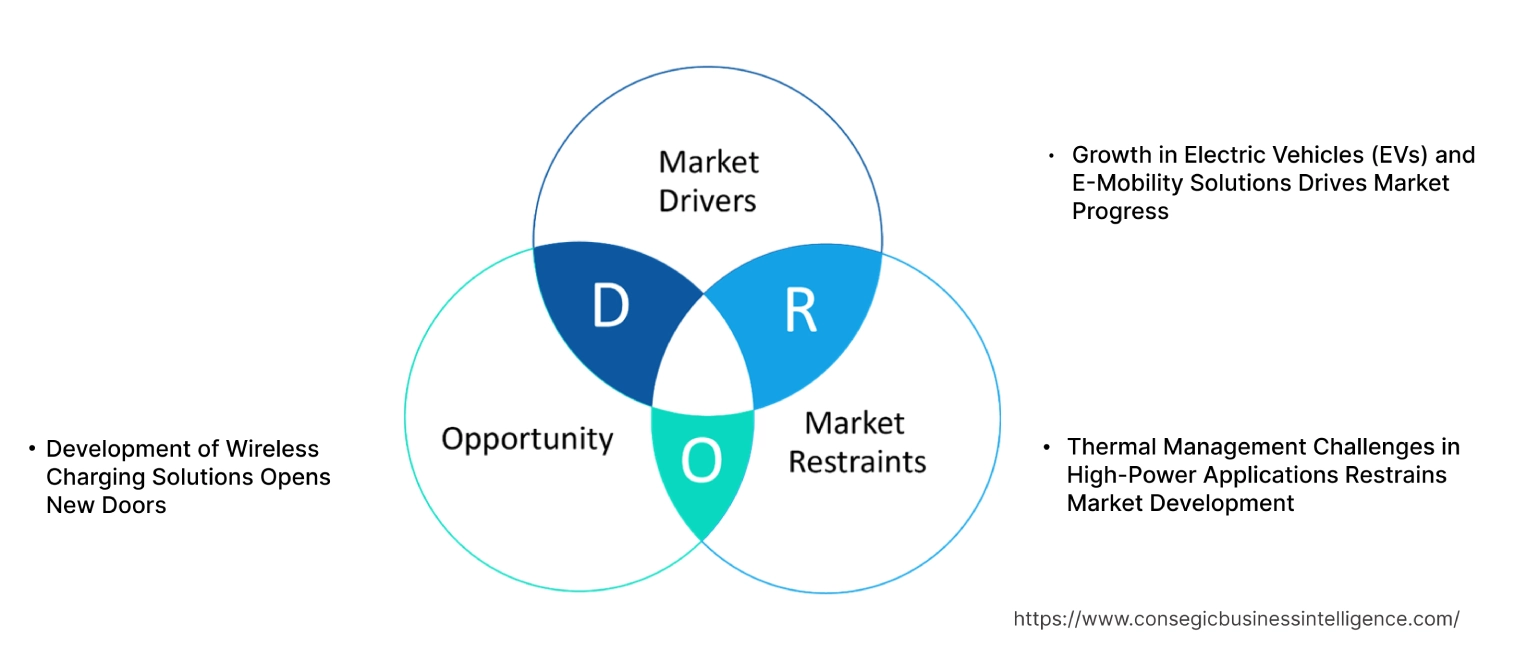Lithium Battery Charger ICs Market Size:
The Lithium Battery Charger ICs Market size is growing with a CAGR of 11.9% during the forecast period (2025-2032), and the market is projected to be valued at USD 43.34 Billion by 2032 from USD 17.63 Billion in 2024. Additionally, the market value for 2025 is attributed to USD 19.67 Billion.
Lithium Battery Charger ICs Market Scope & Overview:
Lithium Battery Charger ICs are specialized integrated circuits designed to safely and efficiently manage the charging process of lithium-ion and lithium-polymer batteries. These critical components regulate the current and voltage delivered to the battery, preventing hazardous conditions such as overcharging, overheating, and overcurrent, which degrade battery life or cause safety risks. By precisely controlling the multi-phase charging cycle, including preconditioning, constant current, and constant voltage modes, these ICs ensure optimal battery health and longevity. Found across a vast array of applications, from portable consumer electronics to high-power electric vehicles and industrial equipment, these charger ICs are indispensable for enabling the widespread and reliable use of modern lithium-based battery technologies.
How is AI Transforming the Lithium Battery Charger ICs Market?
There is an emerging use of AI in the lithium battery charger ICs market. AI enables dynamic, real-time optimization of charging cycles, improved battery longevity through adaptive parameter adjustments, and enhanced safety by predicting and preventing hazardous conditions such as overcharging or overheating. Moreover, AI-powered systems are used for accelerating the design and development of new charger ICs, in turn optimizing thermal control and voltage regulation, along with providing predictive maintenance capabilities for large-scale battery systems. Thus, the above factors are anticipated to boost the market growth in upcoming years.
Lithium Battery Charger ICs MarketDynamics - (DRO) :
Key Drivers:
Rising Adoption of Portable Electronic Devices to Drive Lithium Battery Charger ICs Market Growth
As consumers increasingly rely on smartphones, tablets, laptops, wearables, and other portable gadgets for daily tasks, there is an escalating requirement for efficient, rapid, and safe charging solutions. These devices which are constantly evolving to be thinner, lighter, and more powerful, necessitate advanced charger ICs capable of delivering quick power replenishment without compromising battery lifespan or overall safety. Lithium Battery Charger ICs address these critical needs by providing precise voltage and current regulation, incorporating robust safety features, and enabling fast-charging capabilities, making them indispensable components in the ever-expanding portable electronics landscape.
- For instance, according to PIB, an impressive 99.2% of mobile phones sold within the India are now produced domestically. This surge in local manufacturing has propelled the industry's value to a remarkable USD 49.17 billion, with exports reaching over USD 15.03 billion in 2024.
Thus, as per the analysis, the growing adoption in consumer electronics is fueling significant Lithium Battery Charger ICs market growth.
Key Restraints :
Concerns Regarding Overheating and Thermal Management to Hinder Lithium Battery Charger ICs Market Expansion
Lithium-ion batteries are sensitive to temperature extremes. Excessive heat during charging results in accelerated degradation, reduced lifespan, and, in severe cases, thermal runaway, resulting in fire or explosion. This inherent risk necessitates sophisticated thermal management systems within charger ICs and the devices they power. Manufacturers face the constant issue of designing highly efficient ICs that minimize heat generation while also integrating robust temperature monitoring and regulation features, particularly as devices become smaller and demand higher charging currents. Overcoming these thermal hurdles adds to design complexity and cost, potentially limiting market growth in applications where space is at a premium or cost constraints are tight, ultimately limiting the overall market growth.
Future Opportunities :
Expansion of Wireless Charging Technology to Create Lithium Battery Charger ICs Market Opportunities.
As consumers increasingly seek the convenience of cable-free power for their smartphones, wearables, and other portable devices, the requirement for specialized ICs capable of managing inductive or resonant power transfer is surging. Apart from electronics, the adoption of wireless charging technology is also expanding in EVs and Lithium Battery Charger ICs, creating potential avenues for market in future years.
- For instance, in 2024, EnerSys launched its NexSys AIR wireless charger, an advanced and space-saving solution designed for diverse Lithium Battery Charger ICss that automates charging and eliminates maintenance by using contact-free charging pads across various battery chemistries, including flooded lead acid, Thin Plate Pure Lead (TPPL), and lithium-ion.
This trend not only drives innovation in IC design for higher efficiency and smaller footprints but also opens new market segments, fostering collaborations between IC manufacturers and wireless charging solution providers creating lucrative Lithium Battery Charger ICs market opportunities over the forecast period.
Lithium Battery Charger ICs Market Segmental Analysis :
By Type:
Based on Type, the market is categorized into Linear Charger ICs, Switching Charger ICs, Pulse Charger ICs, Multi-Cell Charger ICs, and Others.
Trends in Type:
- Trends indicate the increasing integration of linear charger ICs in IoT-enabled devices and energy-efficient applications across industries.
- The rise in consumers’ requirement for faster charging times and smaller, more portable chargers leads to the adoption of switching charger ICs.
The Linear Charger ICs segment accounted for the largest Lithium Battery Charger ICs market share of 35.40% in 2024.
- Linear Charger ICs is perceived by their straightforward and cost-effective approach to charging.
- These integrated circuits regulate the charging current by scattering excess voltage as heat, means the voltage difference between the input power source and the battery is reduced across an internal pass element.
- They find their application in consumer electronics, which includes smartphones, tablets, and wearables, where space and cost restrictions are important.
- Thus, as per the Lithium Battery Charger ICs market analysis, based on the above-mentioned factors, the linear charger ICs segment dominates the Lithium Battery Charger ICs market demand.
The Switching Charger ICs segment is expected to grow at the fastest CAGR over the forecast period.
- Switching charger ICs provide superior efficiency and ability to handle higher charging currents.
- Unlike linear charger ICs, which disperse excess input voltage as heat, switching charger ICs consists of a more complex structure that swiftly switches power elements on and off.
- This allows them to convert input voltage to the desired charging voltage for the Lithium battery with much greater efficiency, which leads to minimization of power loss and heat generation.
- Thus, according to the market analysis, the switching charger ICs segment is expected to be lucrative over the forecast period.
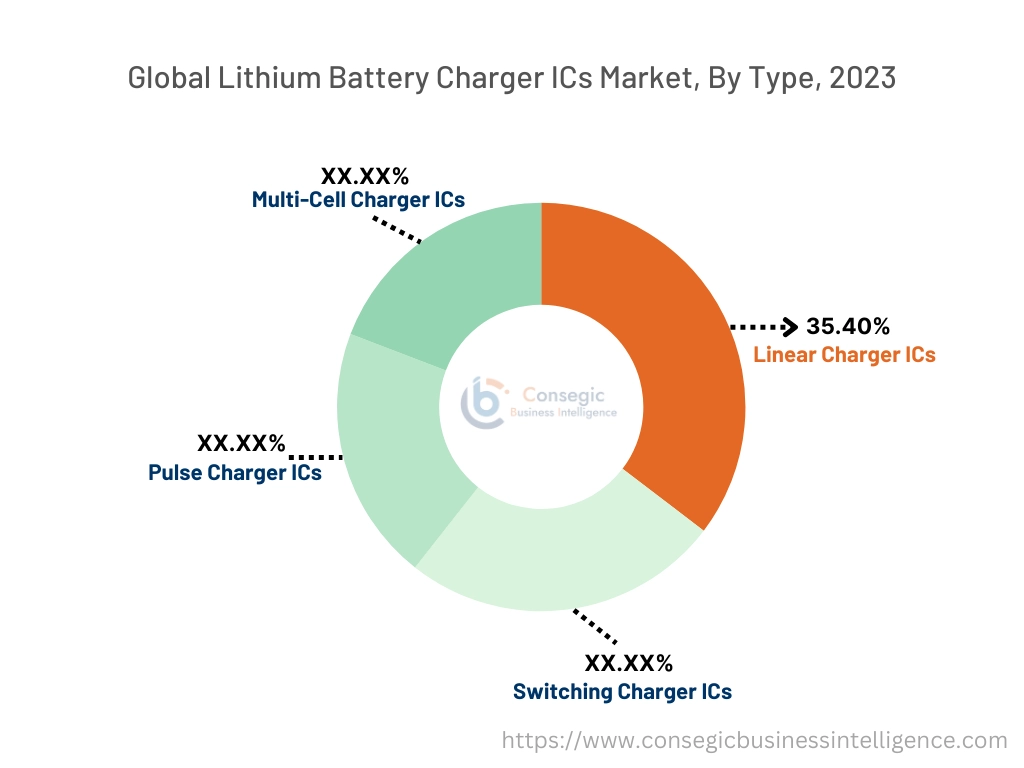
By Battery Type:
The Battery Type segment is categorized into Lithium-Ion (Li-Ion), Lithium Iron Phosphate (LiFePO4), and Lithium Polymer (LiPo).
Trends in the Battery Type:
- There is a growing trend for advanced lithium-ion batteries which provide high energy density.
- The growing requirement for faster charging capabilities is influencing the use of LiPo batteries.
The Lithium-Ion (Li-Ion) segment accounted for the largest Lithium Battery Charger ICs market share in 2024.
- Lithium-ion batteries are widely used rechargeable batteries that support a wide range of applications in consumer electronics, automotive, and industrial sectors.
- These batteries generally provide high energy density, longer lifespan, and low self-discharge rates.
- These properties make them ideal for powering portable devices and electric vehicles.
- Charger ICs for these batteries are designed to enhance the performance of the batteries, with features such as temperature monitoring, overcharging protection, and others.
- There is a growing requirement for these batteries mainly in sectors such as automotive.
- For instance, the data by IEA states that, automotive lithium-ion (Li-ion) battery demand increased by about 65% to 550 GWh in 2022, from about 330 GWh in 2021.
- Thus, based on the market analysis, the Lithium-Ion (Li-Ion) segment is influencing the Lithium Battery Charger ICs market trends.
The Lithium Polymer (LiPo) segment is expected to grow at the fastest CAGR over the forecast period.
- LiPo batteries are categorized by the use of a polymer electrolyte instead of a liquid electrolyte.
- This difference benefits LiPo batteries because of their enhanced flexibility which allows them to be manufactured in a thin pouchlike design.
- These batteries are widely used in compact and lightweight devices, such as drones, wearables, and medical devices, due to their flexible form factor.
- Charger ICs for LiPo batteries is engineered to handle their specific charging requirements, ensuring safety and efficiency.
- The segment's rapid growth is driven by the rising adoption of LiPo batteries in innovative applications, including robotics and portable healthcare devices.
- Charger ICs for LiPo batteries is mainly engineered to handle specific charging requirements. They also ensure safety and efficiency.
- As a result, owing to the aforementioned factors, the Lithium Polymer (LiPo) segment is expected to be lucrative over the forecast period.
By End-Use:
The End Use segment is categorized into IT & Telecom, Healthcare, Automotive, Aerospace & Defense, Consumer Electronics, and Others.
Trends in the End Use:
- Trends in smart home devices and IoT-enabled gadgets are fueling the adoption of advanced charger ICs in consumer electronics.
- Growing requirement for electronic vehicles is influencing the use of charger ICs.
The Consumer Electronics segment accounted for the largest market share in 2024.
- Lithium Battery Charger ICs provide portable, powerful, and safe consumer electronics.
- Consumer electronics, including smartphones, laptops, and wearables, are the primary users of lithium battery charger ICs due to their high dependence on rechargeable batteries.
- Their design and unique protection features allow devices to reliably control the high energy density of lithium batteries.
- These ICs ensure faster charging times and improved energy management, enhancing user convenience and device performance.
- Thus, as per the market analysis, this use of these chargers is driving continuous innovation and user satisfaction in the vast and rapidly evolving consumer and eventually drives the lithium battery charger ICs market demand.
The automotive segment is expected to grow at the fastest CAGR over the forecast period.
- The automotive sector is a growing end-use sector for lithium battery charger ICs, influenced by the rising global shift towards vehicle electrification and the increasing integration of novel electronic systems within conventional vehicles.
- Charger ICs play a major role in advancing battery performance by providing features such as regenerative braking and energy recovery.
- The rise in the requirement for electric vehicles and the use of batteries in them is influencing the use of these chargers.
- For instance, the data by IEA, states that in China, battery requirement for vehicles grew over 70%, while electric car sales increased by 80% in 2022 relative to 2021.
- As a result, owing to the aforementioned factors, the automotive segment is expected to show a lucrative growth over the forecast period.
Regional Analysis:
The regional segment includes North America, Europe, Asia Pacific, the Middle East and Africa, and Latin America.
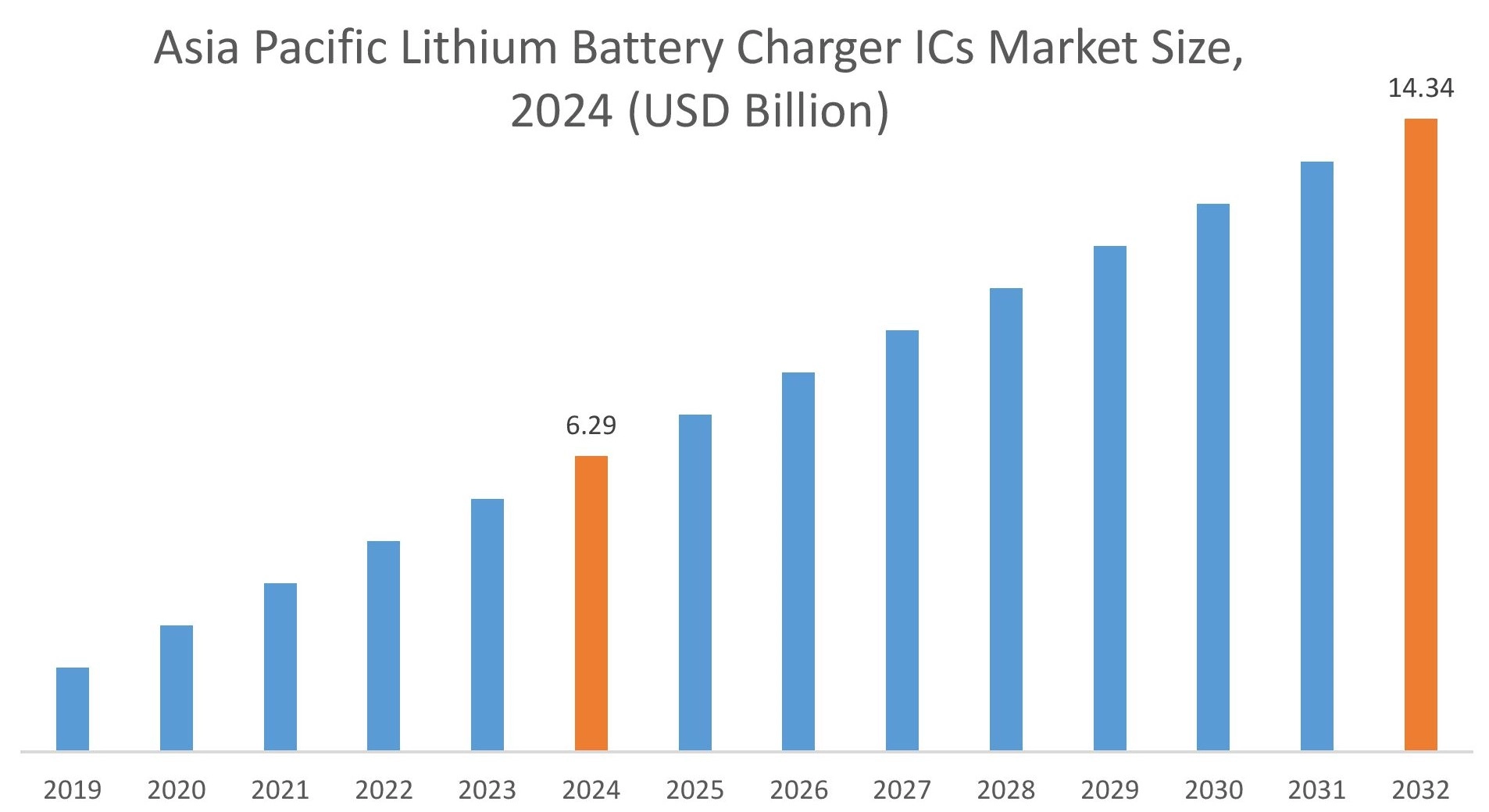
In 2024, Asia Pacific accounted for the highest market share at 35.67% and was valued at USD 6.29 Billion and is expected to reach USD 14.34 Billion in 2032. In Asia Pacific, China accounted for a market share of 38.23% during the base year of 2024.
The upwards trajectory of region is primarily distinguished by electronics manufacturing, particularly in consumer electronics like smartphones, laptops, and wearables among others. This creates a growing requirement for advanced charger ICs. Furthermore, the significant rise of the electric vehicle (EV) sector in countries such as China, Japan, and South Korea, coupled with growing government support and significant investments in battery manufacturing and renewable energy storage systems, directly fuels the need for high-performance and safe charging solutions.
- For instance, according to IBEF, Under Phase-II of the FAME India scheme, the Ministry of Heavy Industries allocated a significant capital subsidy USD 96.13 million. This substantial funding aims to facilitate the establishment of 7,432 Electric Vehicle Public Charging Stations across the nation, demonstrating a strong governmental push towards bolstering EV infrastructure.
Thus, as per analysis, This dynamic ecosystem of production, innovation, and widespread adoption positions APAC as a key region for the market.
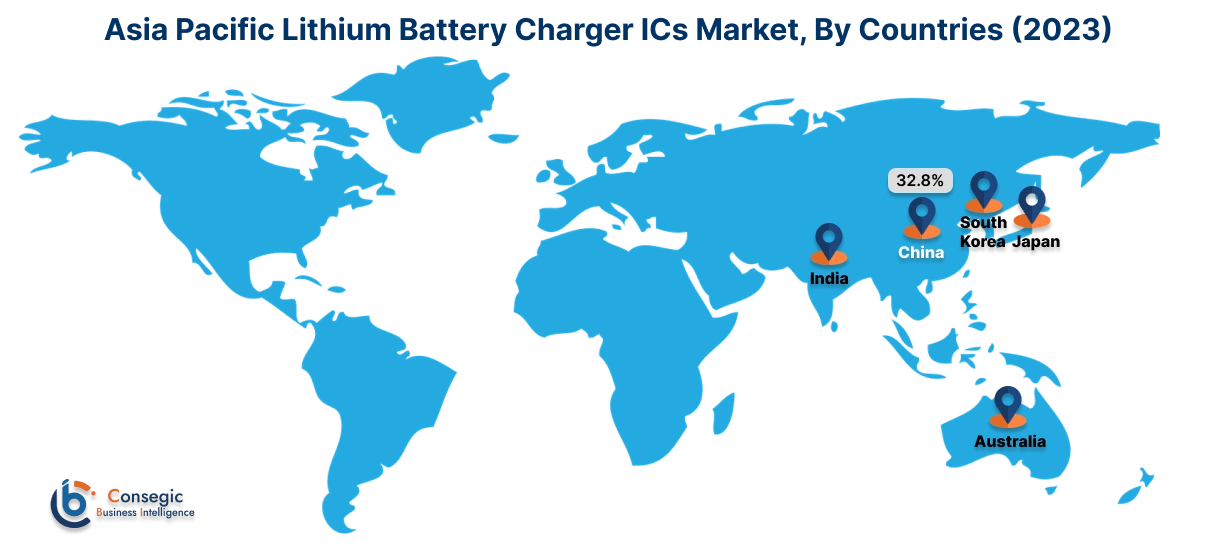
In Europe, the Lithium Battery Charger ICs industry is experiencing the fastest growth with a CAGR of 12.1% over the forecast period owing to the region's strong commitment to electric vehicle adoption and ambitious sustainability goals. Stringent European Union emission regulations and incentives, including targets like the ban on internal combustion engine vehicles are accelerating the shift to EVs and, consequently, the requirement for high-performance battery charger ICs. Furthermore, Europe's increasing focus on renewable energy integration and the deployment of advanced energy storage systems necessitate efficient charging solutions. The presence of major automotive manufacturers and continuous investments in battery technology and charging infrastructure also contribute to this robust market across the continent. Collectively these factors fuel Europe lithium battery charger ICs market analysis.
North America market is defined by its robust technological landscape and high adoption rates of advanced electronics. The surging requirement for electric vehicles is a primary factor, with increasing investments in charging infrastructure and a strong consumer shift towards electric mobility demanding high-power, efficient, and reliable charger IC solutions for vehicle battery packs. Additionally, the region's strong consumer electronics market continuously fuels the need for compact, fast-charging, and feature-rich charger ICs. Furthermore, expanding industrial automation and renewable energy initiatives contribute to the sustained growth of this market across the continent. Hence, as per analysis, these factors collectively present a positive impact on the North American market trends.
The lithium battery charger ICs market expansion in Latin America is largely propelled by the increasing adoption of automation and robotics across its industrial sectors. Countries across the region are witnessing substantial investments in Industry 4.0 technologies, including industrial robots and Lithium Battery Charger ICs. As these industries modernize, the reliance on battery-powered automated systems for tasks such as material handling, assembly, and quality control intensifies. This directly translates to heightened requirements for robust, reliable, and efficient charger ICs capable of supporting the demanding power requirements and continuous operation of industrial automation and robotics equipment, thereby driving the upward lithium battery charger ICs market trend.
The market in the Middle East and Africa is characterized by the rise in the telecommunications sector. Countries in the region are rapidly investing in upgrading and expanding their mobile network infrastructure, including the deployment of 5G technology, which necessitates reliable and high-capacity backup power solutions for cell towers and data centers. Lithium-ion batteries are increasingly preferred over traditional lead-acid batteries due to their superior energy density, longer lifespan, and lower maintenance requirements, making efficient Lithium Battery Charger ICs critical for ensuring uninterrupted service and optimizing operational costs across the MEA telecom landscape.
Top Key Players & Market Share Insights:
The Global Lithium Battery Charger ICs Market is highly competitive with major players providing products to the national and international markets. Key players are adopting several strategies in research and development (R&D) and product innovation to hold a strong position in the global Lithium Battery Charger ICs market. Key players in the Lithium Battery Charger ICs industry include
- Texas Instruments Incorporated (U.S.)
- Analog Devices Inc. (U.S.)
- NXP Semiconductors N.V. (Netherlands)
- Toshiba Corporation (Japan)
- Maxim Integrated (U.S.)
- Microchip Technology Inc. (U.S.)
- Monolithic Power Systems, Inc. (U.S.)
- ON Semiconductor Corporation (U.S.)
- New Japan Radio Co. (Japan)
- Richtek Technology Corporation (Taiwan)
Lithium Battery Charger ICs Market Report Insights :
| Report Attributes | Report Details |
| Study Timeline | 2018-2031 |
| Market Size in 2031 | USD 43.34 Billion |
| CAGR (2024-2031) | 11.9% |
| By Type |
|
| By Battery Type |
|
| By End-Use |
|
| By Region |
|
| Key Players |
|
| North America | U.S. Canada Mexico |
| Europe | U.K. Germany France Spain Italy Russia Benelux Rest of Europe |
| APAC | China South Korea Japan India Australia ASEAN Rest of Asia-Pacific |
| Middle East and Africa | GCC Turkey South Africa Rest of MEA |
| LATAM | Brazil Argentina Chile Rest of LATAM |
| Report Coverage |
|
Key Questions Answered in the Report
How big is the Lithium Battery Charger ICs market? +
In 2024, the Lithium Battery Charger ICs market is USD 17.63 Billion.In 2024, the Banking Encryption Software market is USD 2.95 Billion.
Which is the fastest-growing region in the Lithium Battery Charger ICs market? +
Europe is the fastest-growing region in the Lithium Battery Charger ICs market.
What specific segmentation details are covered in the Lithium Battery Charger ICs market? +
By Type, Battery Type, and End Use segmentation details are covered in the Lithium Battery Charger ICs market.
Who are the major players in the Lithium Battery Charger ICs market? +
Texas Instruments Incorporated (U.S.), Analog Devices Inc. (U.S.), Microchip Technology Inc. (U.S.), Monolithic Power Systems, Inc. (U.S.) are some of the major players in the market.
